应用构造型来扩展模型元素
使用配置文件向 System Composer™ 中的组件、端口和连接器添加属性。导入现有配置文件、应用构造型并添加属性值。
在本主题中,您将学习如何:
将配置文件导入模型或字典。
将构造型应用到模型元素并添加属性值。
使用属性检查器删除构造型。
有关配置文件术语的信息,请参阅使用配置文件扩展 System Composer 语言元素。
导入配置文件
配置文件编辑器与打开它的模型无关,因此您必须将新配置文件明确导入到模型中。首先,将配置文件以 .xml 为扩展名保存。然后导航至 建模 > 配置文件 > 应用于 ![]() 。选择要导入的配置文件。一个架构模型可以有多个配置文件。
。选择要导入的配置文件。一个架构模型可以有多个配置文件。
或者,通过导航至 建模 > 配置文件编辑器 打开配置文件编辑器。您可以将配置文件导入到任何打开的字典或模型中。
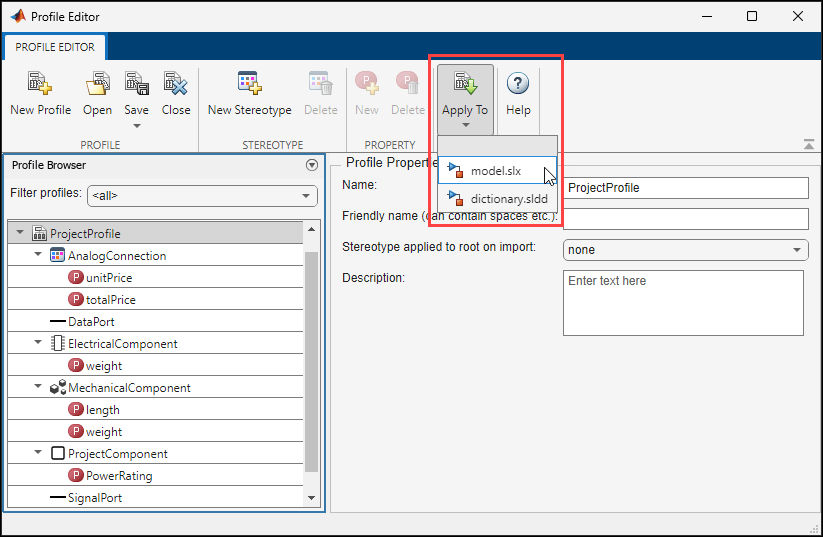
要将配置文件导入到与引用组件链接的 Simulink® 模型中,请打开配置文件编辑器,然后从应用于中选择链接的模型。
注意
您可以为通过 Reference Component 模块链接到 Simulink 行为模型或子系统的 System Composer 组件应用构造型并为端口分配接口。在将构造型应用于组件之前,必须将配置文件导入到模型或子系统中。在将接口分配给端口之前,必须将数据字典导入模型或子系统。
要管理导入的配置文件,请导航至 建模 > 配置文件 > 管理 ![]() ,打开管理配置文件工具。
,打开管理配置文件工具。

点击管理构造型顺序按钮可更改导入配置文件中构造型的优先级顺序。有关详细信息,请参阅使用“管理配置文件”工具更改构造型顺序。
应用构造型
使用属性检查器或“应用构造型”对话框将构造型应用到架构模型元素。您还可以快速插入应用了构造型的新组件。有关在软件架构中将构造型应用于函数的信息,请参阅将构造型应用于软件架构的函数。
使用属性检查器应用构造型
配置文件在模型中可用后,导航至 建模 > 属性检查器,打开属性检查器。选择一个模型元素。

从构造型列表中选择构造型。只有适用于当前元素类型(例如端口)的构造型才可供选择。如果不存在构造型,您可以使用 <新建/编辑> 选项打开配置文件编辑器并创建一个。

当您将构造型应用于元素时,一组新的属性会以构造型的名称出现在属性检查器中。要编辑属性,请展开此集。
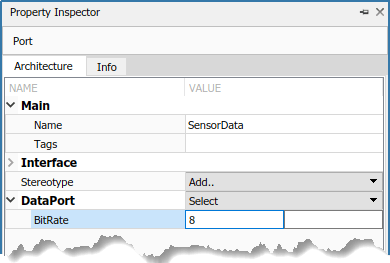
您可以为每个元素设置多个构造型。
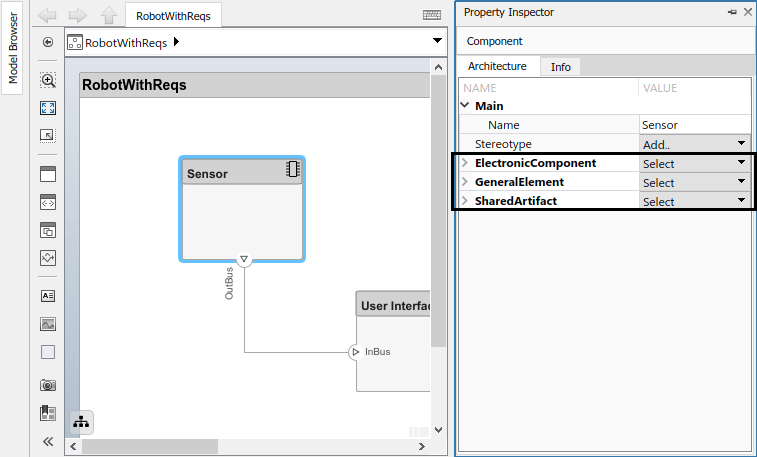
批量应用构造型
您还可以将组件、端口、连接器和接口构造型应用于同一架构级别下的所有适用元素。导航至 建模 > 应用构造型。在“应用构造型”对话框中,从将构造型应用于中选择顶层架构、所有元素、组件、端口、连接器或接口。

您还可以通过选择单个模型元素来应用构造型。从作用域中选择所选项、此层或整个模型。
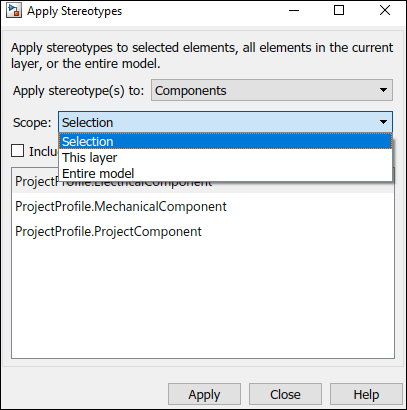
您还可以将构造型应用于数据接口或值类型。当接口在本地定义,并且您在接口编辑器中选择了一个或多个接口时,作用域的选项为所选项和局部接口。

当接口存储在数据字典中并共享时,如果您在接口编辑器中选择了一个或多个接口,则作用域的选项为所选项和 dictionary.sldd 或当前使用的字典名称。
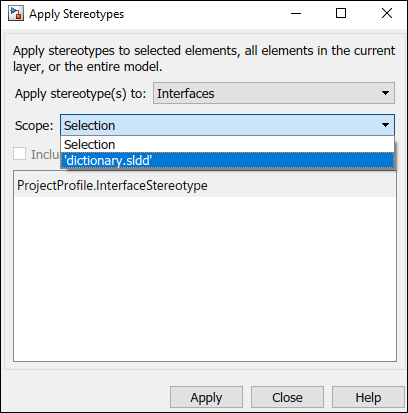
注意
要使构造型在字典中的接口中显示,必须在“应用构造型”对话框中将配置文件导入字典。
快速插入应用构造型的新组件
您还可以通过双击模型画布上的任意位置调出快速插入菜单,创建一个应用了构造型的新组件。选择构造型作为完全限定名称,例如 Profile.Stereotype。创建具有该构造型的组件。

更改构造型
要更改应用于模型画布上的模型元素的构造型,首先创建构造型的层次结构。在给定构造型的配置文件编辑器中分配一个基本构造型值,以继承基构造型的所有属性。有关基本构造型的更多信息,请参阅扩展构造型。根据需要扩展层次结构,以向系统描述中添加更多细节。
使用 System Composer 模型画布上下文菜单和属性检查器来更改构造型,而不会更改共享属性的值。您可以向上或向下移动一个级别,在配置文件编辑器中定义的构造型层次结构中。有关改变构造型信息的更多信息,请参阅基于构造型层次结构改变可移植 Blender 架构中的构造型。
您还可以使用 changeStereotype 函数将分配给模型元素的构造型向上或向下更改任意级别的层次结构。
删除构造型
如果不再需要某个元素的构造型,可以使用属性检查器删除它。在构造型旁边,点击选择,然后选择删除。
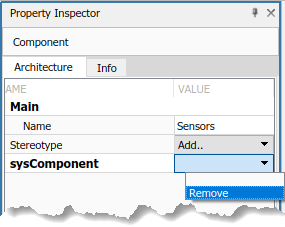
注意
当您的配置文件与 Reference Component 模块未同步时,系统可能会提示您在诊断查看器中进行修复。此选项删除与引用组件中的定义不匹配的构造型。